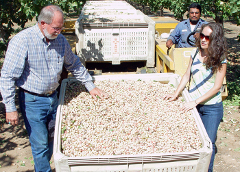California Agricultural Technology Institute
Pistachio study will provide resource information for emission control efforts
 A Fresno State plant science specialist is leading an initiative to help California’s
farming industry evaluate and control greenhouse gas (GHS) emissions generated by
production agriculture.
A Fresno State plant science specialist is leading an initiative to help California’s
farming industry evaluate and control greenhouse gas (GHS) emissions generated by
production agriculture.
Professor Bruce Roberts, the J.G. Boswell Chair of Agronomy, was awarded a $300,000 research grant to assess the total energy required to produce, process and distribute a pistachio crop. He will also monitor the amount of GHG emissions produced.
“Increasing concerns about anthropogenic-caused climate change has created new governmental regulations and shifts in consumer decisions at both the wholesale and retail levels,” Roberts said about the study. “The Cap-and-Trade system for GHG reductions being proposed in Congress is an additional example of looming programs that will impact agricultural production and processing.”
Roberts chose pistachio production because it represents a prominent California commodity crop that will likely be affected by new environmental regulations.
“California pistachios are shipped to consumers around the world, making it an important export commodity,” he said. “At the same time, recognizing consumers’ demand for information on food safety and environmental stewardship issues is critical for continuing growth in these markets.”
He added that major agricultural suppliers are positioning their products to meet more environmentally sustainable and consumer acceptable guidelines. The establishment of an emissions trading market in the European Union and the Chicago Climate Exchange in the United States is an example of changing guidelines.
This pistachio study will calculate the “direct-effect life cycle energy” it takes to produce and distribute a crop. He will measure the energy used to establish an orchard, monitor annual water use, fertilizer and pesticide applications, assess the cost and depreciation of machinery used in all production areas, and record the amount of fossil fuels and electricity used to operate machinery and to irrigate.
Other areas being monitored include the energy costs of transporting product to processors, processing, storage, handling and distribution.
“The goal of this study is to quantify the net energy use and GHG emissions of California pistachio production, processing and distribution,” Roberts said.
The two-year project will be completed in three phases. Phase 1 is an industry-wide survey on production inputs to obtain representative sample information from growers on their production practices.
Phase 2 will focus on the energy-use assessment and evaluation of GHG emissions for annual harvesting, transportation and processing of the crop. Researchers will accomplish this by using a modified version of a biofuel assessment simulator to analyze data.
Phase 3 will identify sustainable industry benchmarks that individual producers can incorporate to assess their production efficiencies to successfully meet the challenge of future GHG regulations.
Information gathered on soil and orchard carbon sequestration will assist in adjusting models to calculate the total life cycle carbon assessments on pistachios.
“This will allow industry comparisons for implementation of cultural changes to improve production efficiencies,” Roberts said. “Given the trends in environmental awareness for sustainable products, a defined production and processing life cycle assessment will enhance global acceptance of California pistachios.”
Assisting in the project is Elena Aguaron, a post-doctoral researcher specializing in environmental horticulture. Aguaron has worked for the USDA Forest Service for five years modeling tree growth and carbon sequestration in the Sacramento area. Her assignment for the pistachio study will be to conduct life-cycle analysis that will allow the assessment of the carbon footprint for this commodity.
Roberts plans to use the next two growing seasons to complete surveys and collect data. Results will be released late next year. He added that applications developed from this project can be adapted to other major commodities grown in California.
In addition to the funds provided by the California State University Agricultural Research Institute (ARI), project support of $150,000 has been pledged by the American Pistachio Growers. For more information, contact Roberts at baroberts@csufresno.edu.